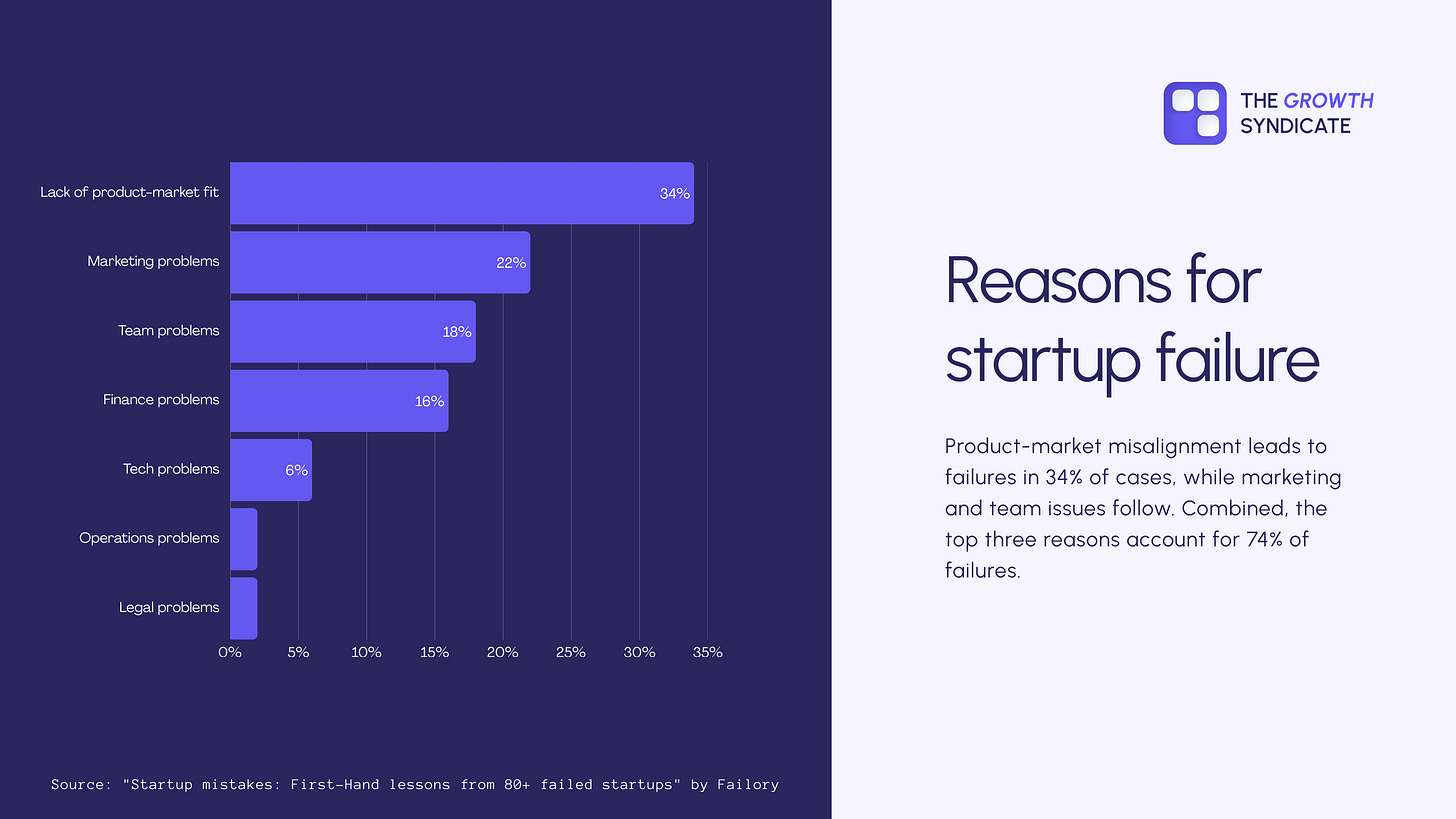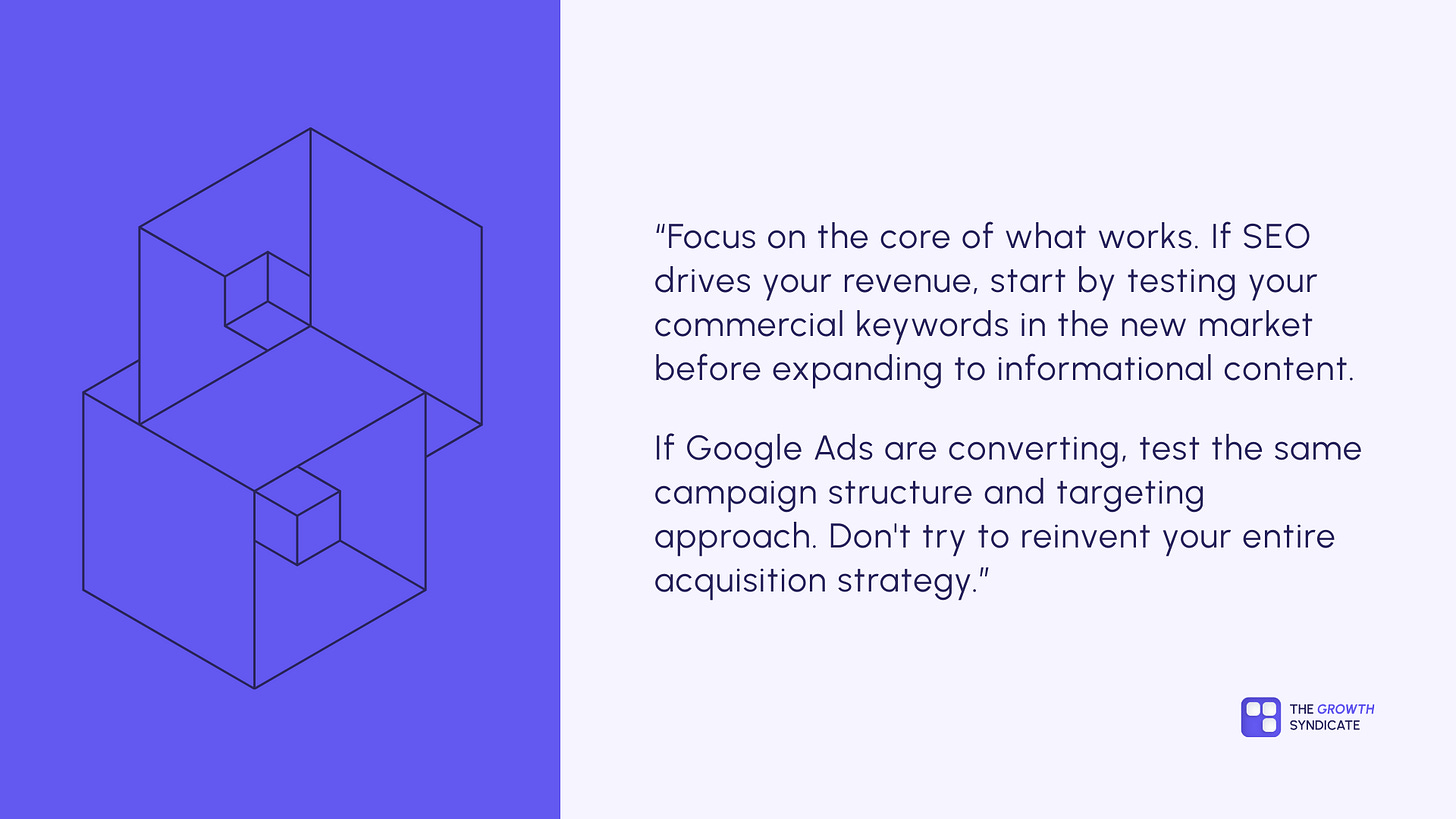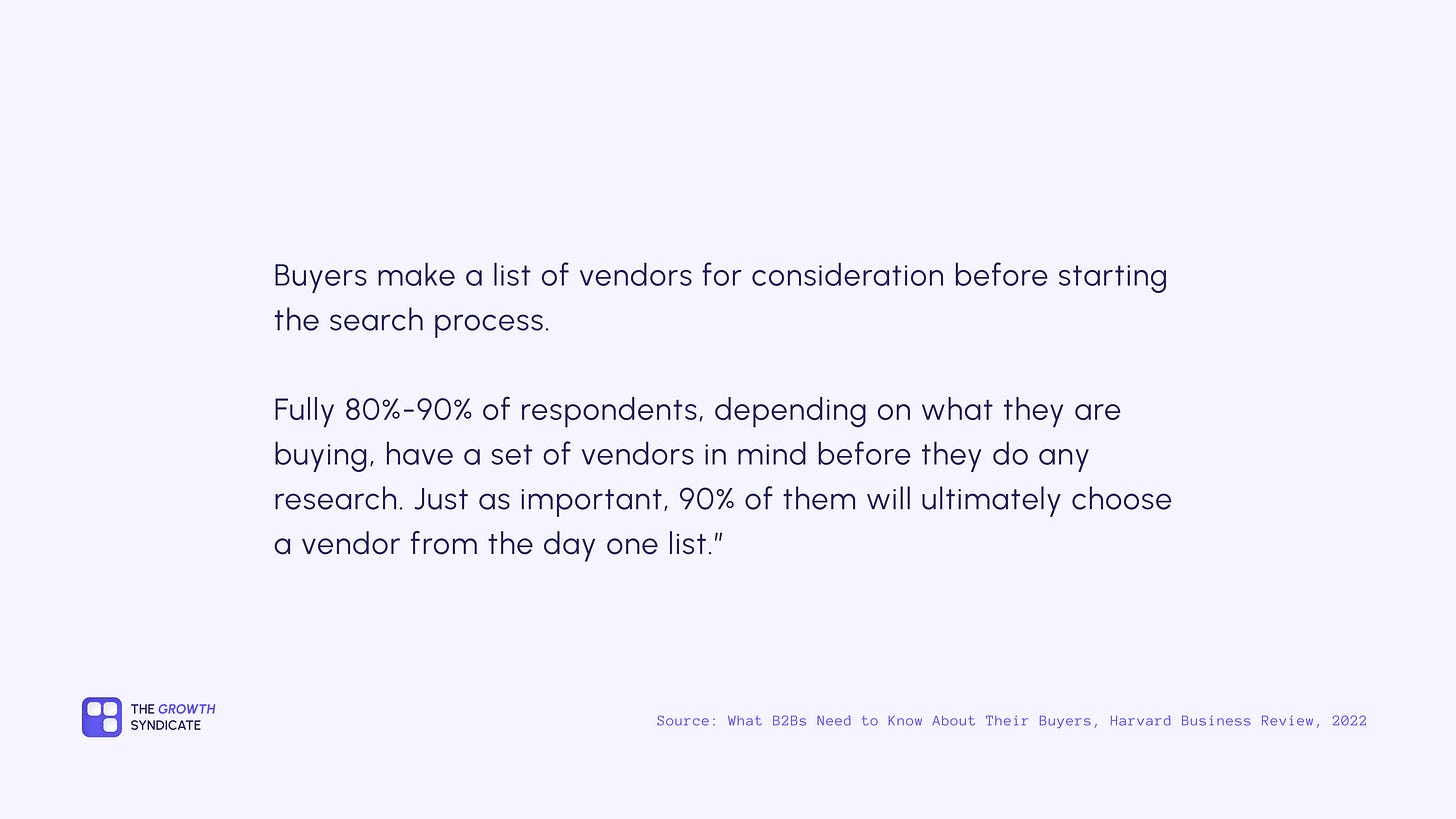A few weeks ago, I hosted a round table at TGS Con called “Expand or Fail: Lessons from over 10 market expansions.” The conversation was more intense than I expected, honestly.
We had founders from completely different backgrounds. B2B SaaS companies, manufacturing platforms, service businesses, all dealing with very different problems.
Your company stage, funding situation, whether you’re doing enterprise deals or mid-market, all of this completely changes how you execute.
A bootstrapped SaaS company expanding to Germany will have a totally different playbook than a Series B manufacturing platform entering the US market.
And the data isn’t really stacked in our favor anyway. Most international expansions lose money, according to Harvard Business Review research¹, with only 40% of companies achieving returns above 3%.
But here’s what became clear during that roundtable: despite all these differences in business model and context, the failures come from predictable mistakes you can avoid.
There are high-level expansion challenges that every company faces, regardless of industry. Things like resource allocation, research, timing, managing internal expectations.
Here are the key lessons that came up again and again in that conversation.
Lesson 1: Don’t follow playbooks blindly (including this one)
I know this sounds contradictory since I’m about to give you a framework, but hear me out. At the roundtable, we had people trying to apply tactics from completely different business models to their own companies.
Take two organizations I’ve worked with recently.
One was a manufacturing platform connecting buyers with suppliers. Nightmarish compliance, relationship-heavy sales, boots-on-ground from day one.
The other was a B2B SaaS tool. They could test with ads, validate demand digitally, then build presence gradually.
Both wanted to expand to North America. Naturally, they’ll have radically different execution strategies.
This is why you need to talk to people who’ve expanded businesses similar to yours. Same industry, similar complexity, comparable business model, and so on.
Their stories will be way more relevant than generic expansion advice.
Listen to people who’ve been there, but stay critical!
Always filter advice through your specific situation. What worked for them might not work for you, and that’s completely normal.
Lesson 2: Product-market fit isn’t negotiable
I’ve seen my fair share of organizations that treat market expansion as a silver bullet for solving domestic growth issues.
They often view expansion as the ✨magic solution that will fix everything✨.
The thinking goes: if we’re not growing fast enough here, maybe we’ll find better opportunities somewhere else.
This is backwards.
About 34% of startup failures are due to a lack of product-market fit.
If you haven’t figured out product-market fit where you understand the customer and competition, expanding elsewhere will only aggravate those problems. In large part because dealing with new markets is considerably more challenging.

But here’s how you know that you’re ready:
- You can clearly articulate who buys from you, why they buy, and what makes them choose you over alternatives.
- You have a repeatable sales process that consistently generates qualified pipeline. If you can’t close customers at home, expansion won’t fix the underlying issues.
Lesson 3: Resource allocation math is not simple
Often what you see is a company asking to “explore” a new market without allocating more resources.
It’s somehow expected that you can do it just as part of your job.
This won’t work because you’ll dilute your activities and it will most likely just affect your home market.
The way I see it, you trade 100% execution in one market for 30% execution across multiple markets.
And small teams can’t afford that.
Ask yourself:
- Do you have the right people for the job?
- Can you sustain growth efforts in two markets financially?
- Can you maintain marketing spend, sales compensation, customer success across both markets for 12-24 months while the new market builds momentum?
I’ve seen companies allocate 20% of their resources to expansion and wonder why they’re not seeing results.
The alternative is to sequence expansion differently. Before you commit execution resources, dedicate a focused team to deep research and validation. This isn’t about splitting execution capacity across markets, it’s about doing proper homework before you make the full commitment.
Lesson 4: Don’t reinvent the wheel
When you expand, your instinct might be to completely rethink your approach. That’s usually a mistake. Start with what’s actually bringing you clients and revenue in your home market, then validate whether it transfers.

Take a company with strong SEO and paid search at home. First thing to test in expansion? Whether their high-converting keyword strategy works in the new market. Maybe the search volume is different, maybe the competition is tougher, but the fundamental approach often translates with adjustments.
This reduces risk because you’re building on proven foundations rather than experimenting with entirely new approaches.
It also helps you identify what’s universally effective about your business model versus what’s market-specific.
Take your core growth motion and test it with focused investment. It’s a narrower version of your home market approach (fewer channels, tighter scope) but within that focus, you still need real commitment.
I’m not talking about throwing minimal budget at it. If SEO is your main driver, you need to commit to proper keyword research and content creation. If your success comes from local sales teams, you’ll need to invest in hiring the right people.
If it works, double down. If it doesn’t translate, then you adapt. But don’t rebuild everything from scratch. Expansion is complex enough as it is.
Lesson 5: Research isn’t optional (even when it feels obvious)
This can seem really textbook-heavy, but it’s definitely important. Don’t open a market just because your founder or CEO says, “We are going there.”
Always ask “why?” and validate.
There are already enough uncertainties when opening a market. You’ll do yourself a great service if you manage to reduce that list by researching the basics:
- What’s the actual TAM?
- Who’s your local competition?
- How do customers behave differently here?
- What compliance and legal hurdles exist?
- What are realistic pricing expectations?
- How do distribution channels work?
But I want to underline that we’re just scratching the surface here. There are plenty more factors to validate depending on what you’re selling and where you’re going.
It’s also important to mention that B2B buyers complete 67-72% of their journey before first vendor contact. That means your research needs to understand not just who buys, but how they research and evaluate before they ever talk to you.

I recommend talking to around 50 people in the new market before making expansion decisions. You need to understand its fundamentals. What’s the market like? How do competitors position themselves? What do customers actually care about?
But always keep in mind that no matter how much research you do upfront, you’ll still need to adapt and rethink your strategy as you start getting real market feedback.
That’s just the reality of expansion.
So yeah, do your homework, but don’t expect it to give you all the answers. It gives you a decent starting point and helps you avoid the most obvious pitfalls.
The real learning happens when you’re actually in the market, talking to customers, and seeing what works.
Lesson 6: Expansion is a strategic decision, not an experiment
Some companies approach expansion like testing a marketing channel. They throw budget at it for a quarter and see what happens. This almost always fails because meaningful expansion takes 12-24 months to show results, especially in B2B.
Think about it from a customer perspective. Data suggests that financial stability and longevity are the top factors B2B buyers consider when selecting vendors. They ranked #1 and #2, respectively in recent Forrester research².
When your market entry signals experimentation rather than commitment (limited local presence, unclear support structure, tentative messaging), it raises questions about your staying power that competitors with established market presence won’t face.
B2B relationships are inherently long-term focused. If your approach signals that you’re testing the waters rather than committing to serve that market, it creates doubt about your staying power.
Budget for at least 18 months before expecting meaningful ROI. Your new market will lag your home market by 12+ months initially. Make sure your team knows this isn’t temporary. Your messaging should convey long-term market commitment.
The companies that succeed treat expansion like building a second business, not running a marketing test.
Lesson 7: Set the right early indicators
Since expansion is long-term, you need leading indicators without expecting immediate ROI. Your new market metrics will underperform your home market initially - that’s normal.
Focus on brand awareness metrics, conversation quality with prospects, partnership pipeline development, content performance. Here’s the key insight: 80-90% of B2B buyers already have vendor shortlists before starting research. Your early indicators should focus on getting onto those shortlists.

Don’t expect these metrics to match home market performance immediately. Your home market has brand recognition, word-of-mouth, established presence. Your new market starts from zero.
I tell companies to expect 6-12 months of foundation-building before conversion metrics resemble home market performance. Focus on leading indicators during this period.
Lesson 8: Localization ≠ translation
Most companies think localization means translating their website and marketing materials. Get everything into the local language, maybe adjust some currency symbols, and you’re done, right?
That’s just the tip of the iceberg.
CSA Research’s study across 29 countries found that 76% of online shoppers prefer to buy products with information in their native language, with 40% stating they will never buy from websites in other languages³. So yes, translation matters. But it’s the baseline, not the strategy.
Real localization means rethinking your entire value proposition. What drives decisions varies significantly by market. Compliance concerns dominate in some regions, cost efficiency drives decisions in others, speed to market matters most elsewhere.
Your pricing, proof points, sales approach - everything adapts. It’s not a one-time project, it’s ongoing work. You test, learn from customers, iterate, repeat.
Companies like HubSpot, which grew from $15.6M to over $2B in revenue through international expansion, demonstrate the power of comprehensive localization strategies that go far beyond simple translation.
Lesson 9: Local expertise is your shortcut
If there’s one expansion shortcut, it’s hiring someone who’s done it before in your target market. Local expertise provides market knowledge, network effects, regulatory navigation, cultural fluency.
You need both relevant industry experience AND deep geographic knowledge. A seasoned business development leader who understands the local market, culture, and regulatory environment often beats a software sales expert who’s never worked in that region.
This hire is often your first major new market investment, so get it right.
You’re not just looking for someone with local market experience. You need someone who can think like a founder or C-level executive.
Someone who will:
- Challenge your assumptions about the market
- Propose changes to your GTM strategy based on local realities
- Think strategically, not just execute a process
- Adapt and iterate quickly when the original plan hits market friction
You want someone who can build and lead, not just follow a playbook from headquarters. This person needs the authority and mindset to make strategic decisions on the ground, because by the time they’re asking permission for every adjustment, you’ve already lost momentum.
But bear in mind that you shouldn’t expect them to single-handedly execute your entire strategy. They’re your foundation, not your complete team.
Lesson 10: Manage internal expectations
Expansion creates internal pressure. Your CEO and board want results quickly, but expansion timelines rarely match those expectations.
Set realistic expectations upfront. Most B2B expansions take 12-24 months for meaningful revenue. There’s big variation in sales cycles - SMB deals close in 30-90 days, enterprise takes 6-18 months.
Clear ownership prevents execution gaps. Who’s responsible for research? Local partnerships? Budget management? These seem obvious until something goes wrong.
Regular communication keeps everyone aligned. Monthly updates covering leading indicators, challenges, adjustments, resource needs. This prevents surprise conversations when executives expect results that aren’t materializing.
Lesson 11: Don’t sacrifice your home market
This might be the most important lesson. Don’t sacrifice home market performance for expansion success. Your home market funds your expansion and covers operational costs.
Remember what I said about resource allocation earlier: “small teams can’t afford to dilute execution”. Resource sequencing, not splitting, is how you avoid that trap. Maintain your primary focus on home market growth while dedicating focused resources to building expansion foundations.
Only shift to balanced allocation once the new market shows clear traction.
Monitor home market metrics closely during expansion. Customer satisfaction, retention, sales velocity can all suffer if you’re not paying attention.
Expansion should add to your success, not replace it. You’re building a multi-market business, not trading one market for another.
The bottom line
Look, the reality is that most companies will still screw up expansion.
Not because this advice is hard to find, but because there are so many moving parts and company-specific elements that can affect the outcome.
The pattern I keep seeing is that companies get excited about the opportunity, skip the boring foundational work, and jump straight to tactics. They hire someone to “run European expansion” without doing the research. They copy what worked for their competitor without understanding why it worked. They spread resources thin because dedicating 18 months to one market feels too conservative.
But here’s what I’ve learned after working with dozens of companies on expansion: boring is profitable.
Most of these lessons aren’t revolutionary. The way I see it, they’re just consistently ignored.
If you’re considering expansion, ask yourself: are you expanding because you’ve maximized your current market opportunity, or because growth has stagnated and expansion feels like the next logical step?
---
¹ Harvard Business Review, “Few Companies Actually Succeed at Going Global” (2015)
² Forrester, “State of Global Business Buyer Trust in 2024
³ CSA Research, “Can’t Read, Won’t Buy - B2C” Study, 2020







